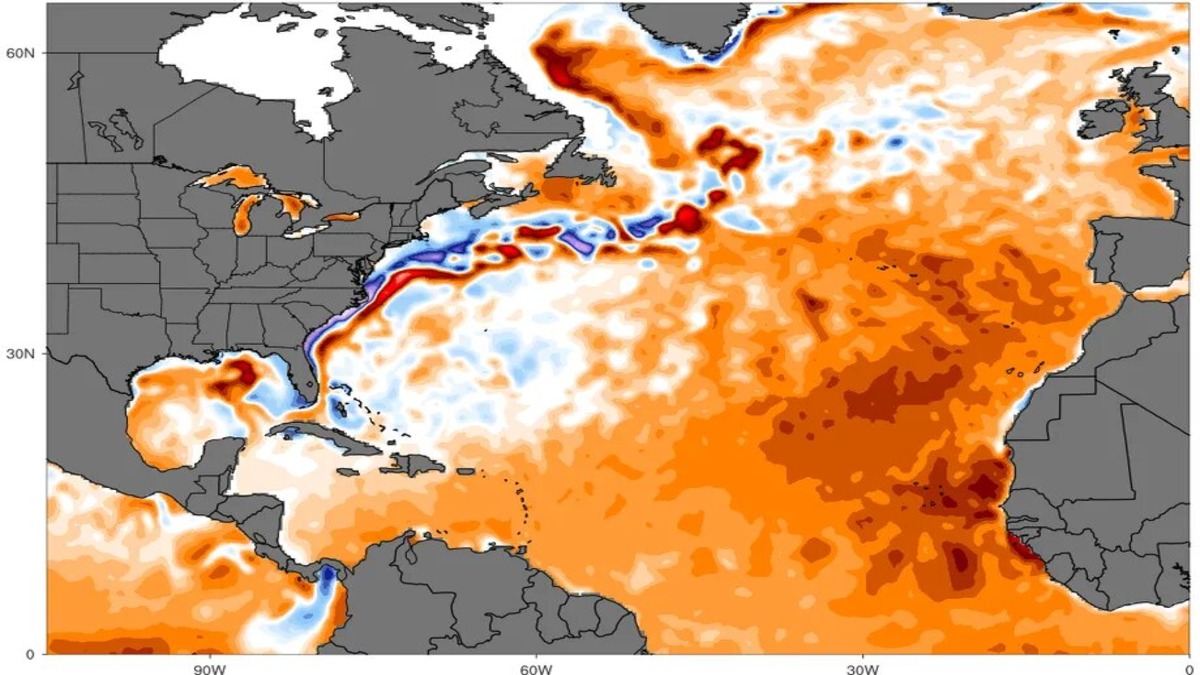Change in sea surface temperatures in the North Atlantic Ocean relative to a historic baseline. Darker orange corresponds to areas that are abnormally warm, whereas blue indicates a region is abnormally cool. Climate Change Institute/University of Maine/NOAA
A map unveils elevated temperatures prevailing across most expanses of the North Atlantic. Alteration in sea surface temperatures within the North Atlantic Ocean in comparison to a historical baseline. Areas veiled in darker orange signify abnormal warmth, while blue denotes regions experiencing abnormal coolness. Climate Change Institute/University of Maine/NOAA Benji Jones, a seasoned environmental correspondent at Vox, delves into the realms of biodiversity loss and climate change. Prior to his tenure at Vox, he held the mantle of senior energy reporter at Insider. Benji’s earlier endeavors encompassed wildlife research. Imagine immersing your toes into the heart of the North Atlantic—perhaps somewhere between South Carolina and Spain—where the water’s touch would evoke a shiver. Swimming would undoubtedly be the last thought on your mind. After all, it’s winter.
Yet, paradoxically, that very water would exude substantial warmth, relatively speaking. Presently, the North Atlantic Ocean stands at an unprecedented warmth, registering approximately 2 degrees Fahrenheit above the average temperature of the past three decades.
To grasp the sheer peculiarity of this occurrence, cast your gaze upon the chart below. A cascade of undulating lines delineates sea surface temperature averages across the North Atlantic, spanning from 1981 to the present day; each undulation symbolizes a distinct year.
The chart delineates 2024’s temperatures as markedly surpassing preceding years, with temperatures thus far in 2024 notably higher than those of 2023. Courtesy of Brian McNoldy (utilizing NOAA data) The bold streak of orange-red traversing the chart’s expanse and towering above its counterparts epitomizes the data from 2023. The North Atlantic began its streak of breaking temperature records in March of the preceding year.
What’s even more disconcerting is the divergence depicted by the truncated line of 2024. It ascends far beyond the rest, indicative of a continued, drastic escalation into the current year.
What queries linger within your mind for our climate team? Share your thoughts by completing this form.
“It’s considerably warmer than ever recorded for this time of year,” asserts Brian McNoldy, a climate researcher at the University of Miami’s Rosenstiel School, in conversation with Vox. “This is deeply troubling,” he recently penned on X.
This surge in warmth poses not only an immediate threat to marine ecosystems, caution scientists. It also serves as an ominous portent of impending perils—perils that may imperil human life.
What catalyzes the Atlantic’s heat surge? A balmy Atlantic serves as a harbinger of the planet’s overarching warming trend. Other indicators abound: This year, vast swathes of the US grapple with an “absent winter,” marked by record-breaking warmth (Minneapolis-St. Paul basked in a record high of 65 degrees earlier this week). Concurrently, NASA corroborates 2023’s status as the hottest year on record.
A recent study published in the journal Nature Climate Change posits that the planet has already exceeded the 1.5-degree Celsius warming threshold established by the 2015 Paris Agreement, aimed at staving off the direst repercussions of climate change. (The study drew upon sea sponges, a diverse category of invaluable marine organisms.)
A scuba diver navigates over alabaster coral formations. A cluster of staghorn coral in the Florida Keys, rendered pallid or “bleached” last summer due to extreme warming. Jennifer Adler for Vox Driving this warming trend are our vehicular emissions, power plant operations, and agricultural practices, which have ensconced Earth in a blanket of heat-trapping greenhouse gases. Astonishingly, around 90 percent of this accrued warmth is absorbed by the oceans; sans their mitigating influence, our predicament would be even graver.
Several more esoteric factors contribute to elucidating why the North Atlantic, in particular, finds itself engulfed in such warmth, as elucidated by my colleague Umair Irfan. Certain regions of the Atlantic experience diminished wind activity, for instance. These winds, besides cooling the ocean’s surface, carry grains of sand and particles of dust from the Sahara, dispersing sunlight back into space (a phenomenon conducive to cooling the ocean). Ironically, a reduction in air pollution—albeit a favorable development—might inadvertently contribute to the ocean’s warming.
Who bears the brunt of a heated ocean? The phytoplankton! The piscine populace! The cetaceans! And ideally, each and every one of us!
#ClimateCrisis #OceanWarming #EnvironmentalAlert #ClimateActionNow #SaveOurSeas
